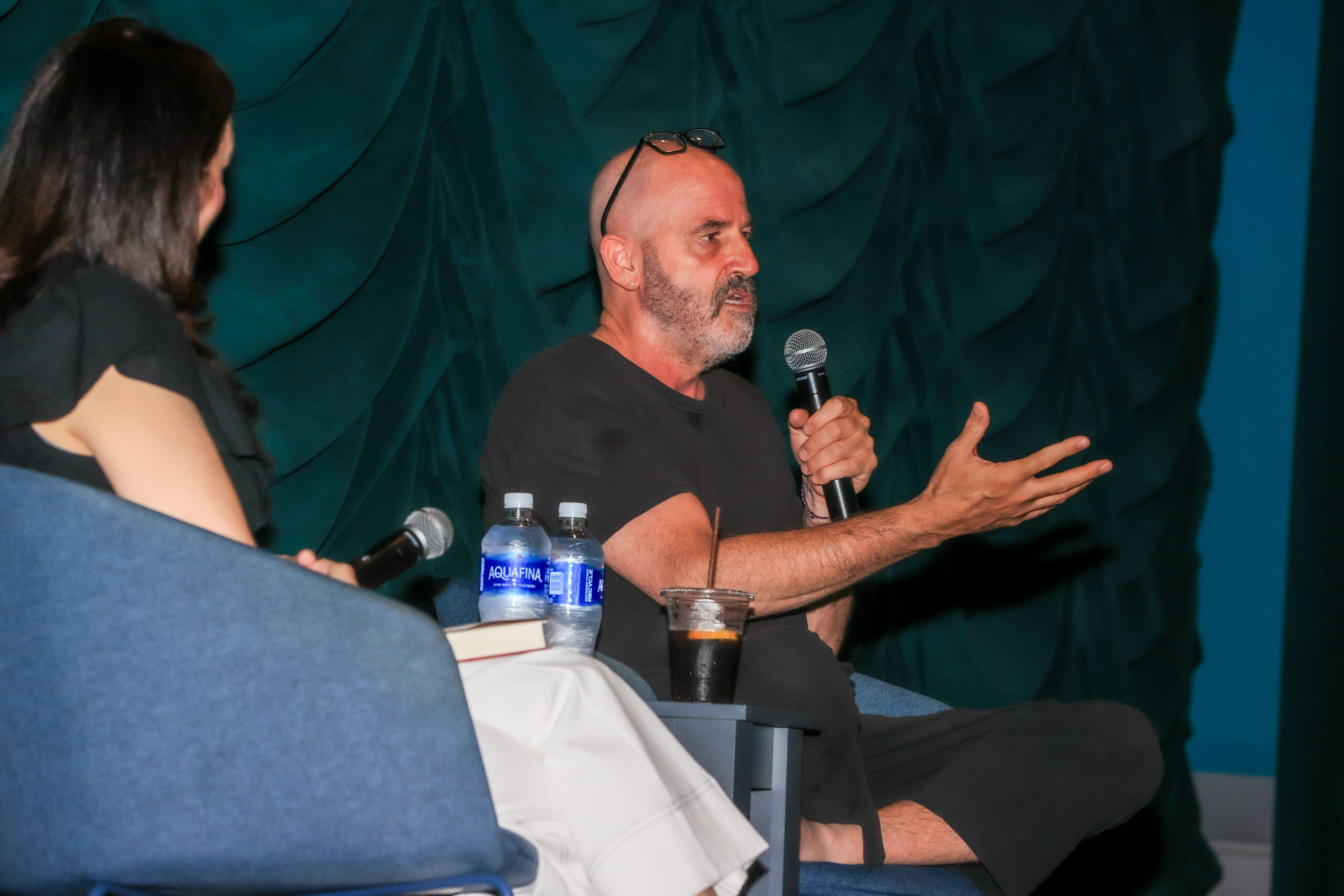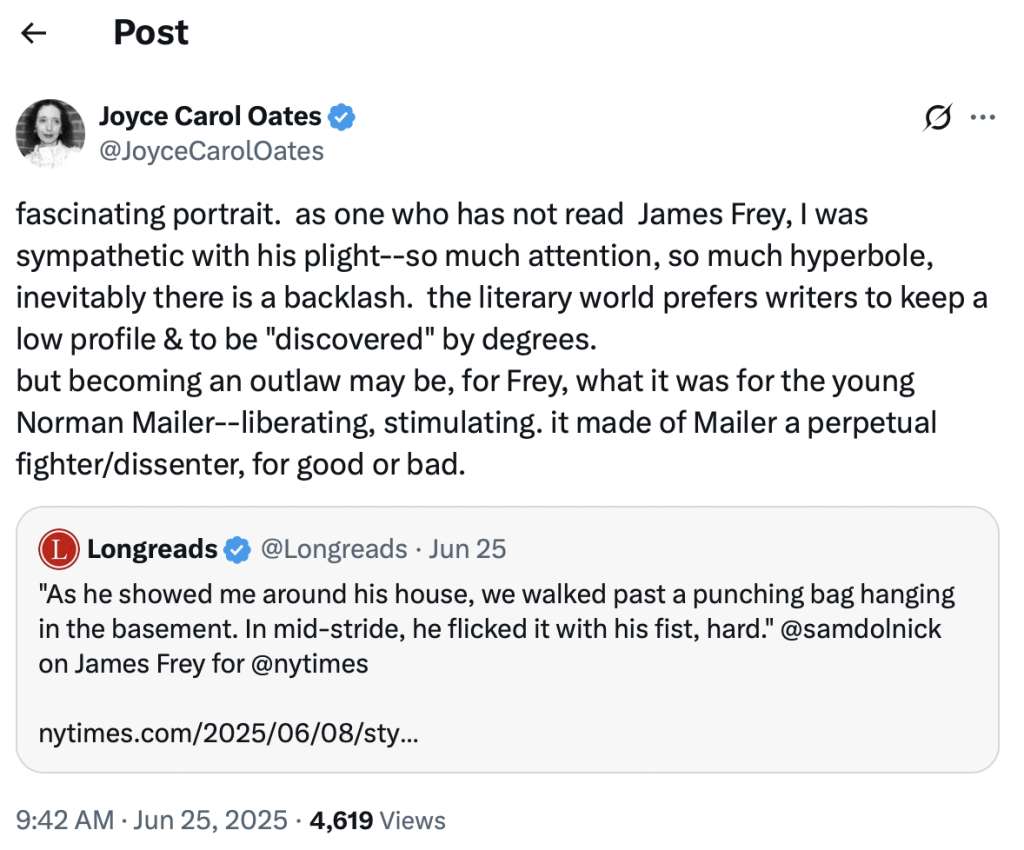Beyond “The Bird”
New Canaan’s Notorious Neighbor – James Frey’s Fictional Drama Hits Close to Home
by Jill Johnson

THE APPROACH TO JAMES FREY’S HOUSE FEELS LIKE A DRIVE THROUGH THE PAGES OF HIS LATEST BOOK
The landscape unfolds with rambling farmhouses and faux French chateaus—each boasting a dozen bathrooms and perimeters marked by quaint fieldstone walls that quiet the opulence. It’s particularly picturesque in the bloom of spring, as perfect as New Bethlehem, the fictional town where Frey’s book, Next to Heaven, is set.
It’s no secret that the setting is modeled on New Canaan; the town’s history, outlined in detail by Frey, and its shops, landmarks and parks mirror our own. But are the characters ours, too? That’s the question that left some residents sleepless in their Frette linens as they anticipated the book’s release in June. And now that the juicy novel is out, reading lights are burning bright across the “Next Station to Heaven.”
In his newest release, Frey draws from the salacious novels of Jackie Collins and Danielle Steele—surprising inspirations for an author who says he pursued writing because of men like Henry Miller, Jack Kerouac and Kurt Vonnegut. But Frey is not what one might expect from a man quick to give the world the middle finger.
Frey’s neighborhood is dotted with the occasional modern home, placing us squarely in The Ice Storm country. New Canaan was also the setting for Ang Lee’s 1997 film based on Rick Moody’s eponymous novel about a key party that wreaks havoc on its characters’ lives and community. Next to Heaven features its own spouse-swapping shindig. It’s the kind of thing that can make a small town edgy. Was it based on an actual swingers party? My mission would be to find out.
Pickle Golf
Golf’s Answer to Pickleball Is Spreading Across the US
Park golf is picking up steam
There’s a sport gaining ground in the United States that has numerous similarities to an already-popular sport here, but with slightly different gear and played with larger balls. If you’re thinking to yourself, “Yeah, we know about pickleball already,” well, it’s not pickleball. The sport is park golf, developed in Japan in the 1980s and beginning to make its presence felt globally.
One park golf course recently opened in the New York metropolitan area — specifically, at Great Gorge Golf Club in Vernon, New Jersey. The club in question has a long history (including an early connection to the Playboy Club) and currently touts the presence of a Tom Fazio-designed course on the premises. As NJ.com’s Rob Jennings reports, though, that’s no longer the only game in town.
Bring Back Tree Forts!
LET YOUR KID CLIMB THAT TREE
It could actually make them safer.
By Henry Abbott

A bunny, small enough to nestle in a cereal bowl, has recently started hanging out in my backyard. Now and again, it nibbles a plant or lies in the sun. Mostly, it explores the limits of movement, zooming, darting, feinting, and trundling through bushes. Once, I saw it corner so hard that it sprayed mulch in a giant, messy arc. A human kid who did that would almost certainly be called inside to clean up. But I haven’t seen the adults in this bunny’s life in weeks; the baby has carte blanche. If only more of the kids I know could be so lucky.
Wild animals are the best movers on the planet, and little ones spend much of their time frolicking, fighting, leaping, and climbing. From birth, human children share animals’ potential for wild movement; left to their own devices, they would presumably tumble about like puppies. But more and more, they do nothing of the sort.
Dialogo de Cecco di Ronchitti da Bruzene in perpuosito de la stella Nuova
Historic Galileo Manuscript Just Set a New Auction Record
The Italian polymath’s first publication reveals his bravery in challenging established doctrines with radical scientific ideas.

Even in the league of genius polymaths, Italian astronomer Galileo Galilei enjoys legendary status. He was the first to systematically study space with a telescope and his inventions include the pendulum clock and the geometric compass. It is no surprise that his works are a hot commodity on the few occasions they come to market.
The celebrated scientist set a new auction record yesterday with an exceedingly rare first edition of his early 17th-century publication Dialogo de Cecco di Ronchitti da Bruzene in perpuosito de la stella Nuova. The landmark achievement of early modern science sold for an impressive £1.1 million ($1.5 million) at Christie’s London’s Valuable Books and Manuscripts sale on July 9. This figure roughly doubled the presale estimate of £500,000–£700,000 ($680,000–$950,000) (final prices include buyer’s fees, estimates do not).
Glass House Summer 2025
Here’s Everything You Missed at the Glass House’s Summer Party
Honoring the late Gaetano Pesce, the annual event in New Canaan brought together a cadre of guests across art, design, and literature for a celebration featuring new exhibitions and a lively dance performance.
by Sam Falb

The Glass House welcomed a design-forward crowd to New Canaan for its annual Summer Party—a vibrant afternoon of art, architecture, and tribute. Honoring the late Gaetano Pesce, the gathering debuted Big Surprise 2, a limited-edition resin vase created with Italian furniture design firm Meritalia and inspired by two Feltri chairs from the host’s own collection.
DJ Pete Brockman set the tone, while Max Mara’s Whitney Bag activation and gelato cart gathered curious eyes across the lawn. As attendees including James Frey and Paul Goldberger; designers Sophie Lou Jacobsen and Maximilian Eicke; artists Deborah Brown and Naudline Pierre; Aldrich Museum Director Cybele Maylone, creative director and curator Abby Bangser, and Phaidon’s Editor-at-Large Spencer Bailey took in the scene, the overarching mood of the afternoon couldn’t be missed—spirited, sculptural, and unmistakably Pesce.
Cloning Ponies
Cloning Came to Polo. Then Things Got Truly Uncivilized
A polo legend and a businessman joined forces to copy the player’s greatest horse. But with a single clone worth $800,000, some technologies are a breeding ground for betrayal.
THE HORSES ARE slick with sweat, veins bulging, feet dancing through a maelstrom of legs and mallets and flying clods of earth, 6,000 pounds of flesh tumbling after a tiny white ball. The riders are all furious angles, jabbing their mallets blindly beneath their saddles. But Adolfo Cambiaso appears calm. He lifts a gloved hand and swings the head of his mallet in a perfect arc through the tangle of horse and human to thwack the ball and send it clear toward the goal. It’s the final game of the 2016 Argentine Open—the most important polo match of the year in the most polo-obsessed country in the world—and there are some 30,000 spectators in the stands, all watching Cambiaso’s every move.
Depending on who you ask, Cambiaso might be described as a horse whisperer, a sex symbol, or a marvel of longevity. And it’s all true: At 41 he’s easily the oldest player on this field, his handsome face and cleft chin sun-beaten and stubbled, his dark hair matted with sweat. But the more universally accepted fact is that Cambiaso is the greatest polo player alive—top ranked for some two decades—if not the greatest who has ever lived. As if that weren’t enough, he’s also a horse breeding tycoon who is, on this very field, in this very game, transforming polo from the sport of kings into a frontier laboratory of applied biotechnology.
Days Gone By
The Concorde-and-Caviar Era of Condé Nast, When Magazines Ruled the Earth
Opulent days are over at Vogue, Vanity Fair and other once-powerful glossies. Anna Wintour is giving up (some) control. Now that everyone’s a gatekeeper, why do we keep recreating their status-obsessed world?

As the longtime editor in chief of Vanity Fair, Graydon Carter was accustomed to big expenses: chauffeured town cars, five-star hotel stays, writer salaries that stretched into the mid six-figures. But in early 2001, he wondered if he had gone too far.
Annie Leibovitz, the magazine’s chief photographer, had run up a $475,000 bill on a cover shoot involving 10 world-famous actresses — Nicole Kidman, Penélope Cruz, Sophia Loren — and an elaborate stage set, complete with a mantelpiece and a genuine John Singer Sargent painting, which was flown from Los Angeles to New York to London. (“It was like Vietnam, the expenses,” Mr. Carter recalled.) Now, he needed to tell his boss, S.I. Newhouse Jr., the billionaire owner and patron of Condé Nast, about the latest line item on his tab.
“I do have to talk to you about something,” Mr. Carter said as the men sat down for lunch. “It’s a good-news-bad-news situation.”
“What’s the bad news?” Mr. Newhouse asked.
“Well, I think we just shot the most expensive cover in magazine history.”
A pause. “What’s the good news?”
“It looks like a $475,000 cover.”
It was the equivalent of roughly $850,000 today. Mr. Newhouse was fine with it.
Conversation at Bedford Playhouse
James Frey Visits Bedford Playhouse for Conversation on Next to Heaven

Bedford Playhouse recently welcomed bestselling author James Frey for a riveting conversation about his latest novel, Next to Heaven—a dark, satirical thriller that delves into the underbelly of America’s wealthiest communities. Dubbed “America’s Most Notorious Author” by TIME and the “Bad Boy of American Literature” by The New York Times, Frey captivated the audience with his insights into the twisted world of privilege, scandal, and betrayal that drives his newest work.
Moderated by author and media executive Fran Hauser, the event offered a lively and thought-provoking discussion on the themes of moral decay, voyeurism, and the extremes of human behavior that Frey masterfully explores in his novel. Guests had the opportunity to purchase signed copies of Next to Heavenand connect with the author in person.
It was a thrilling evening of literature, conversation, and candid storytelling—true to form for one of the most provocative voices in contemporary fiction.
Death Valley Driver
Death Valley National Park is so hot that cars keep catching on fire
Cars, not heat, are the biggest problem in the deadly park
By Farley Elliott, SoCal Bureau Chief

Somewhere around Towne Pass, elevation 4,956 feet, the tractor trailer’s brakes started to squeal and sputter. Descending through Death Valley National Park in the predawn hours, the big rig — with cargo in tow from somewhere deep in Nevada — struggled to slow down. Then, the cab began to heat up.
By first light on June 19, the 18-wheeler was toast, having succumbed to the heat and inevitable flames from overheated brakes while trying to maneuver through the hottest place on Earth. The tractor portion of the rolling beast was burned beyond recognition, its engine block seemingly melted solid. The white cargo trailer had, smartly, been disconnected by then. It sat on the rocky desert shoulder, waiting for a ride. Hopefully this one wouldn’t burn to a crisp, too.
“Listen, kid, we’re all in it together.”
Terry Gilliam Reflects On ‘Brazil’ As Film Celebrates 40th Anniversary & The Challenges Of Getting Movies Made Today: “I Really Don’t Want Any More Fights”
Veteran filmmaker Terry Gilliam is headed to the Umbria Film Festival in Italy, where a screening next weekend of his iconic 1985 dystopian black comedy Brazil will celebrate the film’s 40th anniversary. Nominated for two Oscars and winning a pair of BAFTAs, the movie centers on Jonathan Pryce’s Sam Lowry, who works in the sprawling archives of a megalopolis ruled by faceless bureaucracy and an all-seeing Information Department. When a band of terrorists begins sowing chaos, Sam escapes the gray monotony of his desk job through vivid, dreamlike visions — until reality and fantasy collide with explosive consequences.
Terrible.
The Beauty and the Danger of the Guadalupe River
Generations of Texans gather at the river’s stunning headwaters, which have been carved by cycles of catastrophic floods.

“When the river takes you, don’t fight it,” my parents told me when I was about nine years old. “If it takes you under, focus your effort on holding your breath—it will push you back up.” We would practice floating on our backs, feet downstream, like tiny giggling canoes moving diagonally across the Comal, Medina, San Marcos, and other lesser currents that made up the landscape of our gorgeous, dangerous childhoods, until we were ready for something bigger.
One of those bigger rivers was the Guadalupe, which runs from the Texas Hill County to the Gulf of Mexico, crossing aquifers and collecting tributaries as it plows southeast with a depth millions of years in the making. Before there were roads or fences, the Guadalupe was already cutting its way through limestone in a slow choreography of water and stone. It’s that clever pathway that makes the river so beautiful. It’s that perseverance through rugged terrain that makes it so deadly.
Villeneuve’s Bond
With Denis Villeneuve on Bond, Amazon MGM Signals a Prestige Approach to the 007 Franchise | Analysis
The “Dune” filmmaker brings both commercial and critical acclaim to the long-running series

After buying the keys to the James Bond franchise, Amazon MGM Studios signaled this week that it plans to create a high-prestige version of the series by setting Oscar-nominated “Dune” filmmaker Denis Villeneuve to direct the first new installment of the franchise since Daniel Craig’s tenure.
Plans for the new Bond movies are under lock and key, but newly installed producers Amy Pascal and David Heyman made a statement with Villeneuve’s hiring: This new Bond will be stylish. It will be big. And it could even make an awards splash.
New Canaan Buzz
New Canaan Darien Editor’s Letter: Buzz about town

There is a book that lives on my nightstand called Me Talk Pretty by the American humorist David Sedaris. I don’t bother to put it back on the shelf because something will remind me of one of the stories, and I will reach for it again and again.
Recently I reread a story in which Sedaris explains how he asks obscure and often silly questions to strangers while traveling because he finds they tend to start fascinating conversations. This reminded me of what has recently become my favorite question to ask people around New Canaan: “Have you heard about James Frey’s new book?”
The replies have been varied and passionate. Frey and his books seem to evoke strong reactions in people. Some locals were excited that his novel, Next to Heaven, was set in New Canaan (or “New Bethlehem” as Frey calls it in the book). Others were skeptical about a book with dark themes and “swingers parties” being set in their hometown. Either way, once advance copies hit Elm Street Books in early June, it quickly became the talk of the town, with everyone wanting to know: Is it fact or fiction?
Frey addressed the rumors in a recent coversation with the actress Gina Gershon at the New Canaan Library. He assured the standing-room-only crowd that it is fiction, not based on real people or events. He also said that it is his job as a writer to “hold up a mirror and tell a story about what I see.”
Those are some real nice melons.
Move Over, $100 Lobster Salad. In the Hamptons, These Melons Cost $400.
Gourmet grocery stores are upping their game in the Hamptons, serving a welcoming wealthy clientele.

It wasn’t even 8:30 on a recent morning when a shopper emptied his basket of dinner ingredients onto the counter of the Farm & Forage Market in Southampton: two king crab legs, two bags of frozen dumplings, two packages of ramen noodles and a bag of dried sea kelp.
The cash register rang up an already eye-popping tally before the customer realized he had forgotten the caviar. He tossed a jar of it onto the counter. The grand total was $1,860.
“I’ll put that on your tab, right?” asked Jonathan Bernard, owner of the tiny, tidy store. The shopper, a private chef who works in a home nearby, nodded and noted he would be back later for truffles.
Semiquincentennial Commences
Countdown to America’s 250th Birthday
The U.S. was in a similarly disjointed mood heading into 1976 but pulled off a spectacular national party.
By Paul Beston
Fifty years ago, the U.S. was anticipating a major national anniversary only 12 months away: the bicentennial of the Declaration of Independence. The road to 1976 was rocky. Americans endured a decade of disorienting social change and tumult ranging from political violence to urban riots. They lost thousands of young men in a traumatic and unsuccessful war. A generational economic boom was over. Social optimism had degenerated into suspicion and bitterness. An American president resigned after a coverup failed to conceal what many had long suspected.
The nation had good reason to eye the bicentennial with caution. But Billboard’s No. 1 song on July 4, 1975, was Captain & Tennille’s “Love Will Keep Us Together,” and a year later, the country got itself together to stage a memorable celebration. On July 4, 1976, tall ships and other vessels from dozens of nations filled New York Harbor. Arthur Fiedler conducted the Boston Pops in a concert before a record-breaking audience of more than 400,000 on the Charles River Esplanade. In Washington, grand marshal Johnny Cash marched at the head of a massive parade down Constitution Avenue. Los Angeles staged its own great procession on Wilshire Boulevard.
Kids On Bikes
A Classic Childhood Pastime Is Fading
Kids on bikes once filled the streets. Not anymore.
By Erin Sagen

Walk down a quiet American street a few decades ago, and chances were good that you’d come across a vision of the Spielbergian sort: a gaggle of school-age children charging down the block on bikes, armed with a steely sense of purpose, and without any protective headwear.
You’re less likely to catch that kind of scene today. Over the course of the 1990s, an average of 20.5 million children ages 7 to 17 hopped on a bike six or more times a year, according to data from the National Sporting Goods Association, a sports-equipment trade group. Only a few decades later, that number has fallen by nearly half, to about 10.9 million in 2023. Of those kids, according to the association, just less than 5 percent rode their bikes “frequently.”
The Bling Kings
‘More Is More’: The Elite Luxury Jewelers Decking Out Athletes
Pros—and even amateurs—are partnering with high-end jewelers to create custom pieces with six-figure price tags and a lot of flash.

Jalen Hurts walked into a postgame press conference in December 2024 wearing what would become the most viral piece of jewelry in pro sports last year: a diamond-encrusted pendant bearing his personal motto, “Breed of One.”
“So that’s what y’all wanted to see, huh?” the Philadelphia Eagles quarterback said as he took his seat in front of the cameras. He was talking about his performance—he threw two touchdowns and ran in a third that game—but the line very well could have been about the chain.
In the lighting of the press room, the Cuban chain and glittering pendant commanded the spotlight. It was jewelry as a statement: a period, a flex, a brand in all caps. A signature chain, custom pendant, or flashy grill can steal the show before an athlete even says a word.
Terminal Lucidity
Flashes of lucidity before death: The debate shaking up neuroscience
Near-death experiences and terminal lucidity raise questions about what we know about consciousness

“My mother had advanced Alzheimer’s. She no longer recognized us and seemed indifferent to the strangers who visited her once or twice a week. The day before she died, however, everything changed. Not only did she recognize us, but she wanted to know what had happened to each of us in the past year.” The testimony of a German woman, collected in 2019 by Alexander Batthyány, director of the Viktor Frankl Institute in Vienna, highlights a case of what has been dubbed terminal lucidity, a brief return of the self in people who seemed to have faded long ago due to brain injuries or Alzheimer’s.
In his book Threshold, Batthyány recounts his research on this little-studied phenomenon, relating cases of family members and healthcare professionals who witness what appears to be a temporary return of lucidity in someone they thought was lost. According to his estimates, up to 6% of people who appear to have lost consciousness forever experience it. In an interview with EL PAÍS, the psychologist defends the importance of studying these cases to understand their significance. For him, they challenge the current notion that the mind is only an emergent property of the brain and that when the brain is damaged consciousness disappears forever.
[ click to continue reading at EL PAÍS ]
Joyce Carol Oates on James Frey and Norman Mailer
Lili Anolik & James Frey Discuss Didion & Babitz
Author Talk with Lili Anolik & James Frey Elm Street Books
July 22 @ 6:00 pm – 7:30 pm

Join us Tuesday, July 22nd at 6:00 PM for an author talk with Lili Anolik, here to share her book Didion & Babitz. Joining her in conversation will be local author, James Frey.
Ticket purchase required and includes a copy of Didion & Babitz. Copies of Next to Heaven by James Frey will also be available for purchase.
About the Book:
Could you write what you write if you weren’t so tiny, Joan? —Eve Babitz, in a letter to Joan Didion, 1972
Eve Babitz died on December 17, 2021. Found in the wrack, ruin, and filth of her apartment, a stack of boxes packed by her mother decades before. The boxes were pristine, the seals of duct tape unbroken. Inside, a lost world. This world turned for a certain number of years in the late sixties and early seventies and centered on a two-story rental in a down-at-heel section of Hollywood.
Least Favorites
James Frey
The infamous author, who is back with a new book, shares his least favorite things—excluding Oprah

James Frey knows what it is like to have been up and down and over and out. Ever since Oprah Winfrey publicly shamed him for fabricating parts of his 2003 memoir, A Million Little Pieces, he’s adopted a Sinatra-esque “That’s Life” attitude. He’s rolled with the punches of cancel culture—but 20 years later, he’s punching back. His new novel, Next to Heaven, centers on a swingers’ party and a murder. It’s sexy, funny, and unafraid to voice taboos—much like Frey’s early work. (Except, this time, there’s no need to call in a fact-checker.) To celebrate its release, the author shares his least favorite things. —Carolina de Armas
Money Addicts
Lalo Schifrin Gone
Lalo Schifrin, Acclaimed Composer of ‘Mission: Impossible’ and ‘Mannix’ Themes, Dies at 93
The Argentine native blended jazz and classical music, earned six Oscar noms and four Grammys and inspired a martial-arts legend.
BY MIKE BARNES
Lalo Schifrin, the six-time Oscar-nominated composer, pianist and conductor renowned for his electric, jazz-infused themes and music for Mission: Impossible, Mannix, Starsky & Hutch and Bullitt, died Thursday. He was 93.
Schifrin, who received an honorary Oscar at the Governors Awards in November 2018, died of pneumonia at a hospital in Los Angeles, his son Ryan Schifrin told The Hollywood Reporter. He lived for the past few decades in a Beverly Hills home once owned by Groucho Marx.
A native of Argentina whose father was the Buenos Aires Philharmonic concert master for more than three decades, Schifrin was trained in the world of classical music before being hooked on American jazz when he was a teenager.
Time Sensitive James Frey (and other interviews)
from Time Sensitive with Spencer Bailey
James Frey on Designing Your Life to Bring Joy

In 2003, when the author James Frey published his first book, A Million Little Pieces—a gut-punch account of his experience with addiction and rehab—nobody could have expected what would come next. Thanks to an Oprah Book Club endorsement, A Million Little Pieces was instantly catapulted to bestseller status, but soon blew up in scandal after Frey admitted to having falsified certain portions of the book, which had been marketed as a memoir. The drama that ensued sparked a media controversy—one that now, around 20 years later, feels petty and misplaced, especially in the context of today’s cancel-culture climate. More than 10 million copies of A Million Little Pieces have sold since, and Frey is still at it, writing, publishing, and pushing the boundaries of his art. His latest novel, Next to Heaven, is a rollicking, raunchy, absurd-yet-not satire about money, murder, and the all-too-human desires for power, pleasure, and greed.
On the episode—our Season 11 finale, in which Frey sat lotus for the entire duration—he reflects on the A Million Little Pieces saga; his long-term study of Taoism; writing as a gateway to vulnerability; and why love, for him, is the greatest drug there is.
Special thanks to our Season 11 presenting sponsor, Van Cleef & Arpels.
[ click to listen at Time Sensitve ]
OTHER INTERVIEWS
BBC Front with Tom Sutcliffe
Totally Booked With Zibby
Writer’s Ink from BookTrib
Moms Don’t Have Time to Read Books
Mulder Questions Frey
Winged Victory of Samothrace
JAMES FREY LETS IT RIP
Inside the world of the notorious “A Million Little Pieces” author, who’s back in the spotlight with a pulpy new murder mystery.
Written by: Paul Thompson

The thing about working for magazines is you end up in lots of cars with men you’ve just met. And so by the time we pull up to the monolithic black house at the end of a long driveway in New Canaan, Connecticut, about an hour from our departure point in New York, the three of us—photographer Adam Powell; his assistant for the day, a contemplative musician whose high school girlfriend had once grown evangelical about this story’s subject; and myself—have already developed not only a plan for the shoot and interview but a shared set of crypticisms to track its progress. This is work. Still, when we step out of the car, we’re transfixed. Alone in the otherwise empty front lawn sits a replica of one of the most recognizable statues in the Western canon: Winged Victory of Samothrace, the goddess Niké missing her head and arms. We stare; we riff; we grow quiet again. Without us noticing, the house’s owner approaches from behind. “The real one is in the Louvre,” he says.
James Frey has lived in New Canaan for more than a decade, and in this house for about half that time, since the split from his wife of 20 years. The black exterior is in contrast with the floor-to-ceiling white inside. When I comment on the paint’s unusual texture (following Frey’s lead, I had removed my shoes and socks during our trek through the tall grass toward the pond in his backyard), he explains that this is what they use on the tops of skyscrapers. He believes it’s the only material that adequately reflects the sunlight that pours in through giant windows. His collection of art is expensive, abundant, indisputably cohesive. Almost as soon as we’ve finished discussing the real Samothrace’s prime placement in Paris—we are, ultimately, four people who can picture the Louvre—Frey is posing for photos in the nook of his living room where he writes, in the weeds outside his bedroom window, on rocks that jut from a creek near a friendly bobcat’s lair, face stoic, one or both of his middle fingers raised.This is early May. Almost exactly 22 years prior, Frey’s first book, A Million Little Pieces, was published to mixed, sometimes tortured reviews but achieved, over the next two-and-a-half years, supernova commercial success. If Frey’s name sparks even the vaguest jolt of recognition, you also likely remember the controversy over the revelation that parts of Pieces had been exaggerated, or fabricated entirely. The book was marketed as a memoir, and Frey had defended it in public as such. Oprah at first lavished him with praise, then later brought him on her show to excoriate him.Since the scandal began in earnest in 2005, Frey, now 55, has given vanishingly few interviews—even when he published Katerina, his first full, literary novel in a decade, in 2018. But he’s evidently reconsidered this approach. In the leadup to the publication of Next To Heaven, his pulpy new murder mystery about an upper-crust town not unlike New Canaan, he’s hired a renowned publicist; when I visit him, he’s in the middle of the long process of sitting for a New York Times profile. At one point, he requests that we go off the record so he can explicate why, exactly, he’s opening himself to this media attention and scrutiny. But what he tells me when my recorder is off is virtually identical to something he says when it’s switched back on: “I want my title back.”
Hot and Sweaty
The Hot and Sweaty Book Launch for James Frey
by DREAM BABY PRESS AND MATT STARR

Last Tuesday we hosted the book launch for James Frey’s new book Next To Heaven published by Authors Equity at Harper’s Gallery in NYC. I’ve been feeling sad recently so it was nice to read some new poems aloud, be around friends, hear some good stories and throw James a big book launch.
Gina Gershon, Carole Radziwill, Matt Starr (your trusted narrator), Lili Anolik, Annie Hamilton, Sarah Hoover, and Laura Desiree read before James came on at the end and closed the show. I’ll detail what each person read below.
The theme was love and sex.
Authors Equity NEXT TO HEAVEN
Let it rip.
On the release of Next to Heaven by James Frey

New Bethlehem is as beautiful and safe and perfect a town as exists in the United States, as beautiful and safe and perfect a town as exists anywhere in the world. But no beauty exists without flaws, however hidden. Absolute safety is but an illusion. No matter what we think or see or believe or feel, perfection isn’t real. And beneath the beauty and safety and perfection of New Bethlehem, there are secrets and there are lies, and there is sadness and there is rage, there is failure and there is desperation, betrayal and heartbreak, hate and violence.
And once or twice in a century, there is murder.
About a year ago, I was boarding a flight from LA to New York, bracing for six hours in a middle seat at the back of the plane. My phone pinged with a text flagging a priority submission. I downloaded, put in earphones to tune out seatmates, and settled in for the ride. And what a ride it’s been.
I had last encountered
James Frey a few decades earlier when I was the sales director for the imprint publishing his debut—a spectacular piece of writing that did spectacularly well until it became spectacularly controversial. Many people got very, very angry at the author.
I wasn’t one of them. To me, the whole thing seemed tragic and operatically fraught. Looking back on it now, compared to so many other literary controversies, this one makes 2003 feel, to me, like the Victorian age—long ago and far away in its earnest morality.
By the time I got off that plane in New York last spring, I knew I wanted to publish James’ new book.
Love & Hate
JAMES FREY’S LOVE/HATE LIST
40 Things James Frey Loves and Hates

Dream Baby Press asked James Frey for a list of 20 things he loves and 20 things he hates.
James Frey was called America’s Most Notorious Author by Time Magazine and a Literary Outlaw by The New York Times. He has written multiple global bestsellers, including A Million Little Pieces, Bright Shiny Morning, and The Final Testament of the Holy Bible. His books have sold more than thirty million copies, and his work has been published in forty-two languages. He lives in a small town in Connecticut.
His new book NEXT TO HEAVEN is out today. Get your copy now and wherever books are sold.
Follow James Frey on Instagram.
Follow Dream Baby Press on Instagram.
THINGS JAMES FREY LOVES:
- A passionate make out, heavy lips, heavy tongue, high school style.
- Cold sweet coffee
- A strong menthol cigarette, once or twice a month
- The joyful nothingness of a long meditation
- Warm swimming pools…
THINGS JAMES FREY HATES:
- Close talkers
- Spittle
- Drunk people
- Bills
- Slow drivers in the fast lane…
Peace in New Canaan
How James Frey Channeled Danielle Steel in Next to Heaven
The writer has a new novel out, and this time, the drama—set among Connecticut’s elite—is all on the page.

James Frey has found peace in New Canaan, Connecticut. In the decades since his memoir of rehabilitation A Million Little Pieces became the center of controversy in the publishing world—it initially found a place in Oprah’s book club before a number of exaggerations and falsehoods were exposed—he’s found a sanctuary away from the limelight.
When we speak, Frey has just returned from a college roadtrip with his son. It’s clear that while family time and a life away from the spotlight are determining factors in his transformation, it’s his home of more than a decade that seems most crucial to his calm attitude, a transformation from the early, irascible, years of his success. Looking out of the picture window in his living room in early April, he says, “It’s just the most beautiful place. It’s majestic.” It’s surprising then, that such an idyllic setting inspired Next to Heaven, his new tale of lies and deceit set among Connecticut’s one percent.
The novel centers on four couples in the town of New Bethlehem, a town which he describes as a “version” of New Canaan. Frey is quick to note, however, that it is his town, “not his neighbors,” that is mirrored in the book. The denizens of New Bethlehem, some new, others very old, shop at the same expensive supermarkets, send their children to the same prestigious school, and play tennis at the same exclusive country club. They also share secrets—financial turmoil, affairs, and drug problems—that threaten to ruin their artfully cultivated image of perfection.

